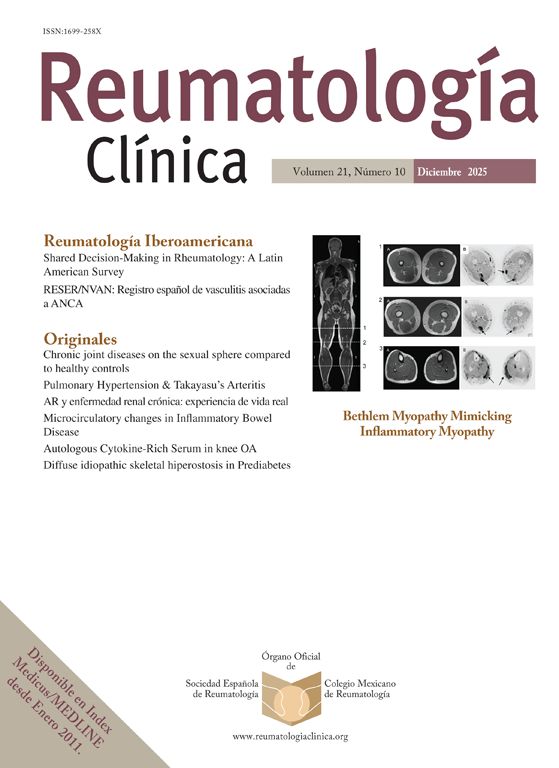Human parvovirus B19 infection is mainly associated with erythema infectiosum or fith disease in children and arthralgia/arthritis in healthy adults.
We describe the case of a patient who presented with chronic monoarthritis of the wrist due to parvovirus B19 and was found to have common variable immunodeficiency (CVID). A 48-year-old man was referred to the hospital because of right wrist monoarthritis lasting six months. Physical examination showed swelling of the right wrist not associated with erythema, warmth or skin lesions. Laboratory analyses showed a white blood cell count of 8300/mm3 (91% granulocytes, 4% lymphocytes), an erythrocyte sedimentation rate (ESR) of 67mm/h and a C-reactive protein (CRP) of 9.4mg/l. Serum electrophoresis demonstrated hypogammaglobulinemia: 0.06g/dl (IgG<8.6mg/dl, IgA<7.8mg/dl, IgM<29.8mg/dl). Rheumatoid factor and antinuclear antibodies were negative. Low values of C3 and C4 were found (64mg/l and 1.5mg/l, respectively). Serologic tests for Borrelia burgdorferi, hepatitis B and C, rubeolla and mumps virus, enterovirus, cytomegalovirus, Epstein Barr virus, human immunodeficiency virus and parvovirus B19 were negative. A bone gammagraphy showed marked fixation of the tracer in the right carpus, suggestive of arthritis. A magnetic resonance displayed diffuse synovitis of the right distal radio-cubital joint, with no signs of necrosis or osteomyelitis. A synovial biopsy was performed; hystopathological studies showed chronic nonspecific inflammatory changes and polymerase chain reaction (PCR) detected the presence of parvoviral B19 DNA in synovial tissue. PCR of parvovirus B19 DNA in blood was positive.
A diagnosis of parvoviral B19 monoarthritis in the setting of CVID was made, and prompt treatment with intravenous immunoglobulin (0.4g/kg every 4 weeks) was administered with complete resolution of articular symptoms after the second infusion. Because of hypogammaglobulinemia, treatment with intravenous immunoglobulin was continued indefinitely. Human parvovirus B19 infection is detected in 3.3% of patients examined for acute reactive arthritis.1 Joint symptoms usually resolve within two weeks; however, 0–17% of patients has chronic arthritis,2 generally a symmetric polyarthritis that can resemble rheumatoid arthritis. Chronic monoarthritis is much less frequent. To our knowledge, five cases of parvovirus B19 chronic monoarthritis have been described: three children3,4 and two adults.5 Diagnosis of B19 infection in immunocompetent individuals is made by detection of B19 specific antibodies in blood. Caution should be made when interpreting serology for parvovirus B19 in immunodeficient patients and pregnant women because of their decreased capacity to mount an antibody response. In these patients, serology should be complemented by PCR analyses of B19 DNA.
In our patient, serologic tests for parvovirus B19 were negative and diagnosis was made by PCR of blood serum and synovial tissue. Even though the presence of parvovirus B19 DNA in synovial tissue does not allow a definite diagnosis, the absence of other causes and the rapid response to intravenous immunoglobulin, led us to assume the viral aetiology of the arthritis.6
CVID is a primary immune deficiency characterized by reduced levels of immunoglobulins of all classes despite normal numbers of circulating B cells. The deficiency in IgG production may lead to recurrent infections with encapsulated organisms, such as Streptococcus pneumoniae and Heamophilus influenzae, causing otitis, sinusitis, bronchitis and bronchiectasis. Septic arthritis with usual bacterial pathogens such as Staphylococcus aureus, S. pneumoniae and H. influenzae and unusual bacteria such as mycoplasma and ureaplasma species, have been described in these patients. Viral arthritis are uncommon; the main causes are adenovirus type I and echovirus 11 and a few cases related to parvovirus B19 have been reported.7 An aseptic no erosive polyarticular arthritis that resembles rheumatoid arthritis is seen in 10–30% of hypogammaglobulinemic patients. These types of arthritis respond well to immunoglobulin replacement treatment.8–10 To our knowledge, only one other case of persistent parvovirus infection leading to a diagnosis of CVID has been reported; it is the case of a 6-year-old boy who presented with a 1-month history of fever and polyarticular arthritis in whom laboratory investigation showed hypogammaglobulinemia. Intravenous immunoglobulin was started 2 weeks into the illness, resulting in prompt recovery.7
This case highlights the importance of considering the diagnosis of parvovirus B19 infection not only in cases of polyarthritis but also in any case of unexplained chronic monoarthritis and the special situation of immunodeficient individuals, in whom serologic tests can be negative.





